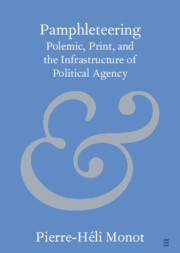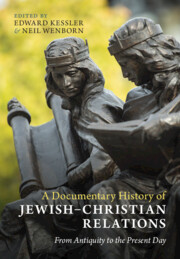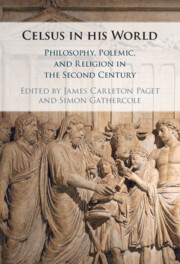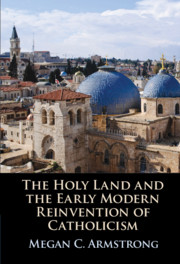Refine search
Actions for selected content:
29 results

Pamphleteering
- Polemic, Print, and the Infrastructure of Political Agency
-
- Published online:
- 05 September 2025
- Print publication:
- 02 October 2025
-
- Element
-
- You have access
- Open access
- HTML
- Export citation
2 - Dialogue Literature
- from Part I - Approaches and Evidence
-
-
- Book:
- The Cambridge Companion to Christian Heresy
- Published online:
- 17 July 2025
- Print publication:
- 31 July 2025, pp 33-53
-
- Chapter
- Export citation
11 - Islam as a Christian Heresy
- from Part II - Case Studies
-
-
- Book:
- The Cambridge Companion to Christian Heresy
- Published online:
- 17 July 2025
- Print publication:
- 31 July 2025, pp 215-232
-
- Chapter
- Export citation
3 - (Counter-)Reformation in Unchristianised Europe
-
- Book:
- Silence of the Gods
- Published online:
- 19 June 2025
- Print publication:
- 19 June 2025, pp 163-220
-
- Chapter
- Export citation
V - The ‘Lonely’ Historian: Contrast and Continuity
-
- Book:
- Authority and Tradition in Ancient Historiography
- Published online:
- 31 January 2025
- Print publication:
- 06 February 2025, pp 217-257
-
- Chapter
- Export citation
Chapter 43 - Aḥlām al-Naṣr and the Islamic State’s Justification for Execution by Burning
- from Part VI - Alternative Sources for Islamic Legal Studies
-
-
- Book:
- Islamic Law in Context
- Published online:
- 14 November 2024
- Print publication:
- 21 November 2024, pp 449-460
-
- Chapter
- Export citation
15 - Divine and Human Plans in the Book of Isaiah
- from Part III - Isaiah as Literature
-
-
- Book:
- The Cambridge Companion to the Book of Isaiah
- Published online:
- 08 November 2024
- Print publication:
- 21 November 2024, pp 243-258
-
- Chapter
- Export citation

A Documentary History of Jewish–Christian Relations
- From Antiquity to the Present Day
-
- Published online:
- 03 October 2024
- Print publication:
- 17 October 2024
Chapter 6 - Affections and Errors of the Soul
- from Part II - Case Studies
-
- Book:
- Medicine and Practical Ethics in Galen
- Published online:
- 14 December 2023
- Print publication:
- 04 January 2024, pp 124-173
-
- Chapter
-
- You have access
- Open access
- HTML
- Export citation
Conclusion
-
- Book:
- On Laudianism
- Published online:
- 05 October 2023
- Print publication:
- 19 October 2023, pp 568-600
-
- Chapter
- Export citation
4 - Agōn and Theological Authority
-
- Book:
- Christianity and the Contest for Manhood in Late Antiquity
- Published online:
- 10 November 2022
- Print publication:
- 24 November 2022, pp 212-271
-
- Chapter
- Export citation
Monks and the Muslim Enemy: Conversion, Polemic and Resistance in Monastic Hagiography in the Age of the Crusades, c. 1000–1250
-
- Journal:
- Transactions of the Royal Historical Society / Volume 1 / December 2023
- Published online by Cambridge University Press:
- 16 November 2022, pp. 5-22
- Print publication:
- December 2023
-
- Article
-
- You have access
- Open access
- HTML
- Export citation
London Catholicism, embassy chapels, and religious tolerance in late Jacobean polemic
-
- Journal:
- British Catholic History / Volume 36 / Issue 2 / October 2022
- Published online by Cambridge University Press:
- 07 November 2022, pp. 153-181
- Print publication:
- October 2022
-
- Article
-
- You have access
- Open access
- HTML
- Export citation

Celsus in his World
- Philosophy, Polemic and Religion in the Second Century
-
- Published online:
- 18 November 2021
- Print publication:
- 25 November 2021
Chapter 3 - The Word in a Box
-
- Book:
- Boxes and Books in Early Modern England
- Published online:
- 25 August 2021
- Print publication:
- 19 August 2021, pp 103-147
-
- Chapter
- Export citation
Chapter 5 - ‘What Is This Monster?’ The ‘Bad’ Politique
- from Part III - C. 1588–94
-
- Book:
- Politics and ‘Politiques' in Sixteenth-Century France
- Published online:
- 08 June 2021
- Print publication:
- 17 June 2021, pp 167-202
-
- Chapter
- Export citation
3 - The Order of the Holy Sepulcher
-
- Book:
- The Holy Land and the Early Modern Reinvention of Catholicism
- Published online:
- 30 April 2021
- Print publication:
- 20 May 2021, pp 121-181
-
- Chapter
- Export citation

The Holy Land and the Early Modern Reinvention of Catholicism
-
- Published online:
- 30 April 2021
- Print publication:
- 20 May 2021
Chapter 4 - Laying Down the Law: Avicenna and his Medical Project
-
- Book:
- Galen and the Arabic Reception of Plato's <I>Timaeus</I>
- Published online:
- 30 October 2020
- Print publication:
- 12 November 2020, pp 140-169
-
- Chapter
- Export citation
Foreword
-
- Book:
- The Founder of Manichaeism
- Published online:
- 16 January 2020
- Print publication:
- 05 March 2020, pp viii-xx
-
- Chapter
- Export citation
